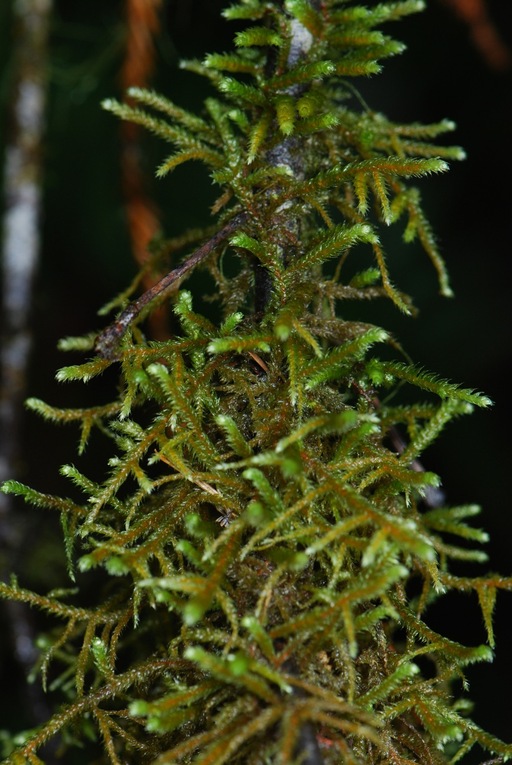Plants forming loose and deep mats; glossy green to yellow green with strongly contrasting reddish stems, mostly with a whitish cast in exposed sites. Primary stems (stolons), secondary stems, and branches little differentiated except as to size with larger axes to 15 cm long, ascending to decumbent, not julaceous, mostly regularly pinnate with branch apices blunt to occasionally attenuate or even flagelliform; paraphyllia absent. Leaves falcate-secund on better developed plants, not imbricate or julaceous, plicate, erect-ascending to spreading, not much altered when dry, ovate to ovate-lanceolate, to 4 mm long, 2–3: 1, with apex acuminate, erect or flexed but not deflexed. Margins serrulate to sharply serrulate from base to apex, recurved but with the angle of that recurvature rather broad, short decurrent. Costa extending about 3/4, strongly flattened and broadened at base filling about 1/3 of that leaf base; forked into 2–4 auxiliary lateral costae. Median Laminal cells smooth and rhomboidal, 6–8 µm wide, 3–5: 1, strongly pitted especially near the base. Basal juxtacostal cells somewhat wider, pitted, with long axes radiating from costa at a 45 degree angle. Apical cells coronate-papillose at least on apical leaves smaller branches. Alar cells thick-walled with rounded to elliptic lumens, numerous, quadrate to transversely elongate, to 14 µm wide, only gradually demarcated from laminal cells, primarily restricted to area of recurved margin. Axillary hairs to 100 µm, 4–6 celled, with 2–3 basal brown cells, not offset from leaf insertion. . Rhizoids red-brown, smooth, to 8 µm in diameter, clustered on expanded abaxial costal base and sometimes on adjacent portions of stem. Juvenile leaves orbicular, strongly overarching the bud. Stolon and stipe cross-section without central strand, with stereome 6–8 cells thick, red-brown, only moderately thick-walled.
Sexuality dioicous with male plants similar in size and morphology to the females. Perigonia nearly spherical, bud-like, densely placed on the main axis and larger branches. Perigonial leaves to 0.8 mm long, broadly ovate with an abrupt, somewhat reflexed acumen, essesntially ecostate, mostly with a limbidium of a single row of rectangular cells. Perichaetia on main axis, much longer than subtending vegetative leaves. Outer perichaetial leaves essentially identical to perigonial leaves; inner perichaetial leaves 4–6 mm long, ecostate to weakly costate, strongly convolute and investing the base of the seta, abruptly acuminate from an elliptic base. Setae pale-brown, 5–10 mm long, erect to somewhat flexuose, smooth. Capsule exserted, erect and symmetric, brown, cylindric, to 3 mm, 2–4: 1, not distorted or sulcate when dry. Exothecial cells mostly isodiametric, 20–30 µm wide with a lumen/wall ratio of 4–6: 1. Operculum conic to apiculate, about 1/4 as long as urn. Annulus absent or poorly developed. Exostome teeth 16, erect and pale, narrowly lanceolate, about 10: 1, papillose but often inconspicuously so.. Endostome segments very narrow, smooth, about as long as exostome and with no basal membrane and no cilia. Calyptra cucullate, smooth or with a few hairs. Spores spherical 20–30 µm, papillose, light brown.
![University of California [UC]](http://ucjeps.berkeley.edu/common/images/logo_uc_80.png)
![University of California [UC]](http://ucjeps.berkeley.edu/common/images/logo_uc_80.png)

